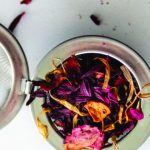Make Tea Part of Your Self-Care Routine This Year (Part 2)
If you read our last blog post you now have some ideas about what to make tea out of, but you may have some questions about how. We have some Tea’rific news for you! Read on to learn more.
Growing Your Own Herbs
Many herbs stay relatively small when grown indoors, making them a great addition to your kitchen window! For best results, ensure that plants have plenty of light and keep in mind that indoor plants tend to need a bit less watering. Indoor herbs can be started at anytime of the year and maybe transferred outdoors during warmer seasons.
Flowers such as Chamomile, Echinacea and Calendula are best grown outside. Early spring, after risk of frost has passed, is most favorable for planting. These sun loving flowers will flourish with full sun to partial shade. Plant Calendula seeds at 1/4” depth, Echinacea at 1/2”, and sprinkle Chamomile on soil and just barely cover. You should begin to see sprouts within a week or two!
Preparing Herbs
Tea is best made with fresh herbs, which is why it’s so great to grow your own. Drying may cause herbs to lose some of their flavor and diminish the potency of their beneficial compounds. However, drying does allow for longer storage, which can also be important for continuing to enjoy your gardens bounty well after the season has come to an end.
Herb can be air dried by hanging or dried more quickly in the oven, at 180 degrees F for 2-4 hours. The herbs are ready to store when the leaves crumble easily. Dried herbs can be good for 2-3 years.
Brewing The Tea
For brewing herbal tea, heat water to about 210 degrees F. For dried herbs, use 1 teaspoon of leaves for every 8-10oz of water. Herbs can be added directly to water or you can use a diffuser, such as a tea ball. Let steep about 5 minutes before enjoying.
Rinse fresh herbs well before brewing. Add about 3 teaspoons of fresh herbs to heated water. Allow to steep at least 5 min before removing the herbs and enjoying. Rinse and repeat as needed.
Sweetener can be added to your liking. Some herbs can be a bit bitter, but a touch of sweetness can cut through the bitter flavor and allows their subtler flavors to come through.
Now that you’re a sage tea sage, what are you planning on brewing? Leave us a comment and let us know! Don’t forget to follow us on Facebook or subscribe to our newsletter, where we’ll keep pouring the Tea!





